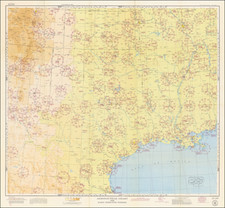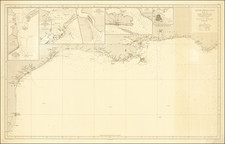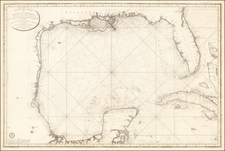An Early Promoter's Map of Texas City, Texas
Rare separately published map of Texas City, Texas, published to illustrate the newly created city.
The map illustrates the progress in the development Texas City, including railroad links, docks (including a sunken barge used for a dock) and a detailed city plan, including a planned hotel at the location of the Artesian Well. Lots which had been sold are marked with a printed X.
Established in 1891 by 3 investors from Duluth, Minnesota, Texas City would go on to be one of the most important port cities in Texas.
Texas City
In 1891, during a duck hunting trip to Galveston Bay, the founders of Texas City recognized that the area known locally as Shoal Point, had the potential to become a major port. Shoal Point had existed since the 1830s, when veterans of the Texas Revolution (1835-1836) were awarded land for their services. By 1874, Shoal Point had a post office. The duck hunters were three brothers from Duluth, Minnesota, named Benjamin, Henry, and Jacob Myers. After they returned to Duluth, they formed the Myers Brothers syndicate, convinced other investors to put up money to buy 10,000 acres of Galveston Bay frontage, including Shoal Point. They renamed the area Texas City.
By 1893, the investors had formed the Texas City Improvement Company (TCIC), which platted and filed the townsite plan. A post office opened in 1893, to serve about 250 people who had moved there from Minnesota and Michigan. TCIC also received permission from the federal government to dredge an eight-foot channel in the bay from Bolivar Roads (at the east end of Galveston Island) to serve Texas City. In 1894, the channel was first used commercially.
TCIC eventually dredged the channel to a 40-foot depth and extended the length of the port to 1.5 mi. TCIC also built a 4-mile railroad to the Texas City Junction south of town, where it connected to two other rail lines: Galveston, Houston and San Antonio and Galveston-Houston and Henderson.
Despite these successes, the TCIC went bankrupt in 1897. Its assets were reorganized into two new companies: Texas City Company (TCC), and Texas City Railway Terminal Company (TCRTC). TCC acquired 3,000 city lots and provided water, gas, and electricity to the town. TCRTC operated the railroad. These companies were chartered on February 4, 1899.
A grid of streets and avenues was laid out during the 1890s, and houses and other structures began to appear. The Davison Home, where the first childbirth in the town took place, was constructed between 1895 and 1897. As the TCIC, the TCC, and TCRTC expanded, urbanization expanded.
Permission was granted in the summer of 1900 to dredge the Texas City channel to a depth of 25 ft. The disastrous Galveston Hurricane of 1900 interrupted the project, washing the dredge ashore. However, the Texas City port remained open after the storm passed. Even before the channel dredging was complete, the first ocean-going ship, SS Piqua, arrived at the port from Mexico on September 28, 1904. Dredging was completed March 19, 1905, when the US government opened a customs house in Texas City. Port growth progressed rapidly after this, from 12 ships in 1904, to 239 in 1910.
Texas City Refining Company was chartered in 1908 to build a refinery adjacent to the port facility. For several years, it was the only Texas refinery capable of producing the byproducts wax and lubricating oil. This facility was later acquired and expanded by Texas oilman Sid Richardson. Three more refineries soon followed, making Texas City a major port for deepwater shipping of Texas petroleum products to the Atlantic Coast.
The Texas City Disaster
On April 16, 1947, the French ship Grandcamp, containing ammonium nitrate fertilizer, exploded, initiating what is generally regarded as the worst industrial accident in US history, the Texas City disaster. The fertilizer manufactured in Nebraska and Iowa was already overheating when stored at the Texas City docks. The blast devastated the Monsanto plant and offices, which were immediately across the slip from the Grandcamp, blew away the warehouses, showered shrapnel from the ship in all directions, and ignited a second ship, the S.S.High Flyer, docked at an adjacent slip. Released from its mooring by the blast, the High Flyer rammed a third ship, SS Wilson B. Keene, docked across the slip. Both ships also carried ammonium nitrate fertilizer and were ablaze. They, too, exploded. In all, the explosions killed 581 and injured over 5,000 people. The explosions were so powerful and intense that many of the bodies of the emergency workers who responded to the initial explosion were never accounted for. The entire Texas City and Port Terminal Fire departments were wiped out.
The steel-reinforced concrete grain elevator was pockmarked with shrapnel and the drive shaft of the Grandcamp was embedded in the headhouse. The ship's anchor was hurled several miles away, where it was discovered embedded in the ground at the PanAmerican refinery. School children and townspeople who were attracted to the smoke also died, and entire blocks of homes near the port were destroyed. People in Galveston 14 miles away were knocked to their knees. Surrounding chemical and oil tanks and refineries were ignited by the blast. At least 63 who died and were not able to be identified are memorialized in a cemetery in the north part of town.
The Texas City disaster is widely regarded as the foundation of disaster planning for the United States. Monsanto and other plants committed to rebuilding, and the city ultimately recovered quite well from the accident. Numerous petrochemical refineries are still located in the same port area of Texas City. The city has often referred to itself as "the town that would not die"
Rarity
The map is very rare. OCLC locates 2 examples (SMU DeGolyer and University of Texas at Arlington).
We are not aware of any other examples offered for sale.









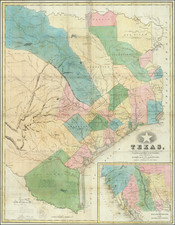
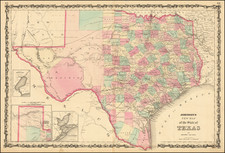
![(Republic of Texas Land Grants with Maps - Coahuila y Tejas) [Manuscript land grant documents issued by Radford Berry, alcalde of Nacogdoches, to John Adams and others, with manuscript plat maps by Arthur Hendrie and George Aldrich]](https://storage.googleapis.com/raremaps/img/small/88920.jpg)
